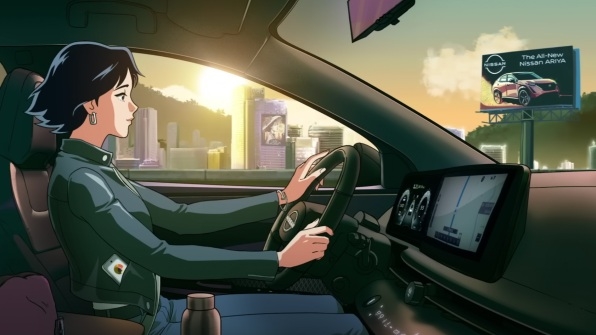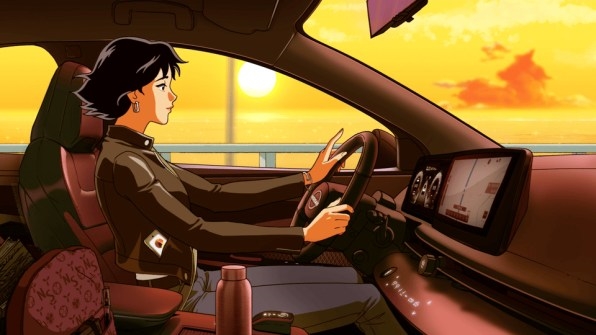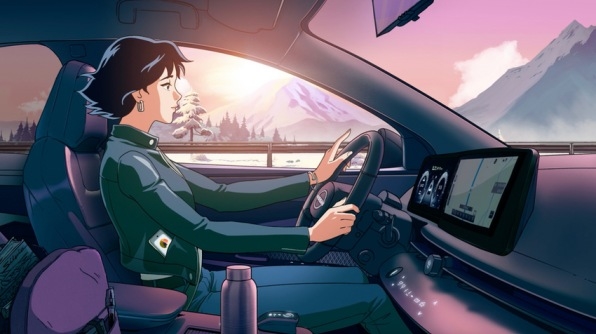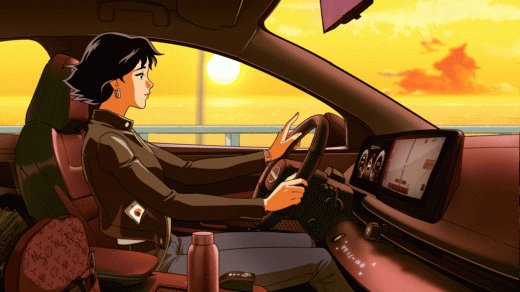How Nissan won the internet with a four-hour ad
By Janko Roettgers
Automaker Nissan recently took a massive gamble: To promote its new electric Ariya SUV, the car company began running a four-hour ad on YouTube. What could have led to outrage instead became a viral success, attracting more than 17 million views and thousands of positive comments.
“This is how commercials should be,” reads one of those comments, while another commenter exclaims: “I didn’t even notice this was [an] ad! I love it so much.”
The secret to Nissan’s success was that the ad was specifically produced for a popular YouTube channel: Lofi Girl, a 24/7 livestream of relaxing instrumental beats, accompanied by the animated video of a girl penning notes while a cat peacefully naps in the background. Nissan’s ad not only uses a similar soundtrack, but also a closely aligned aesthetic. The video features an animation of a woman driving through a beautiful countryside, very occasionally passing subtly placed billboards for the Nissan Ariya.

The ad’s visuals were produced by Titmouse, a Los Angeles-based animation studio best known for the TV shows The Venture Bros. and Big Mouth. Titmouse creative director Simón Wilches-Castro explains that Nissan wanted the project to look and feel like Lofi Girl, but also reflect its own Japanese heritage—an aspect that made him immediately think about his own travels to the country.
“I’ve been to Japan so many times,” he says. “Every time I jump on a train, I just stick my phone on the window. I have hours of video of Japanese background scrolling through.”

Those video recordings inspired the ad’s changing backgrounds, which include snowy trees, far-away mountains, and a sunset-soaked coastline. The style of these visuals was inspired by traditional Japanese woodblock printing, with an anime twist: Every now and then, gigantic monsters pop up on the horizon, to the delight of YouTube’s commenters.

“I really wanted to work with this idea that there are these huge creatures, but they are part of the background,” says Wilches-Castro. “These creatures are usually associated with chaos, but (the driver) doesn’t seem to be bothered.”
Nissan isn’t the first company to experiment with unusually long ads. In 2011, Canadian casual-dining chain Swiss Chalet aired a 13-week nonstop broadcast of roasting rotisserie chickens; in 2014, the Association Right to Die with Dignity unveiled a 25-hour PSA. But while those efforts were primarily about generating headlines, Nissan had another reason to go for four hours: The company wanted to make an ad that would last roughly as long as its new electric SUV can drive on a single charge.
The carmaker ended up not emphasizing this aspect in its final messaging. Driving style and terrain can have a huge impact on an electric vehicle’s battery usage, and Nissan didn’t want to make any promises it may not be able to keep. But, regardless, YouTube’s audience didn’t take issue with the ad’s length. “Listened to the full four hours. Enjoyed every beat,” reads one of the comments. “Man, how can a literal 4-hour advertisement be so calming,” wonders another commenter.
“People are stumbling into this, and then just forget what they were going to look for because they just lose themselves in this world,” observes Wilches-Castro.
Nissan worked with Google on the original idea for the ad, which then partnered with Titmouse and the New York-based creative studio The Mayda Creative Co. on development and execution. Lydia Corin, Mayda’s director of creative partnerships, credits the close alignment with YouTube’s Lofi Girl channel for the ad’s success. “We knew who the audience was from the beginning,” she says. “[We built] something incredibly impactful that [is] part of culture and doesn’t disrupt it.”
A little more than two months after its debut, the ad has now become the second-most-popular video on Nissan USA’s YouTube channel. Judging from the number of commenters who say they added it to their playlists, it may be well on its way to taking the top spot.
Wilches-Castro freely admits that he didn’t expect the ad to be that successful. “The fact that this anime girl is now the big star of their [YouTube] channel is a shock to me,” he says, adding that his aspirations were not to break records. “We’ve had such a difficult couple of years. I just wanted to make something relaxing.”
(24)



